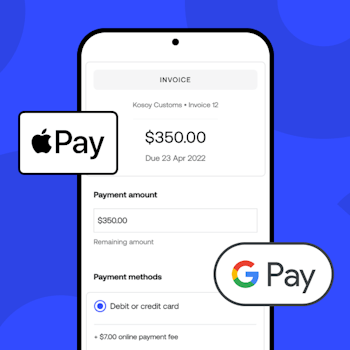
4 essential time management tips for freelancers and small business owners
Time management skills matter even more in 2020. Whether you’re freelancing or at a traditional 9-5, you’re more likely to be working from home these days. As of June 2020, 42% of the US workforce lives and works in the same place – and the numbers are similar in the UK and Australia.
You may enjoy having a more flexible schedule, commuting less, or having more time for family. However, focus and time management can be tricky when there are fewer ways to distinguish between work and home.
Chances are that you already have a ton of work on your plate. Finding the time market yourself, get your job done on time, and stay on top of your books can be overwhelming at times.
We at Invoice2go, a Bill.com company, want to help make all of that a little easier. We’ve put together a series of articles to help both new and seasoned freelancers have more success. We want you to avoid unnecessary struggles and have more space to focus on the joy that comes from doing work that you love.
Here are 3 essential tips and tricks to improve your time management skills and overall productivity.
1. Create a workspace sanctuary
Although you’re living and working in the same space, you want to set up distinct work and relaxation spaces. Perhaps you have a room in your house you can set up as your office. Even part of your bedroom or living room will do.
One of the most important time management skills is to have a specific space where you work each day. This will help you subconsciously build habits, and your body will begin to associate that space with productivity. If space is limited within your work-life setup, consider a collapsible computer table. You can set it up in the morning and fold it up at the end of the day.
Keys to an ideal workspace
Your desk and workspace should feel comfortable, and you want to feel happy sitting there. You can decorate your workspace in a way that feels good. Make sure that you have appropriate light so that you’re not straining your eyes.
If you have the budget, an adjustable desk and ergonomic chair are worthwhile investments. Set your work surface at the correct height. When you’re comfortable, you’re also less likely to get distracted. Also, you’re going to spend many hours here, so you want to protect your health.
Organize and keep your space uncluttered
Having the tools to stay organized is essential. Folders, cubbies, and other tools can help you have the materials you use most ready to go. Think about the materials you use most and make sure they’re easily accessible from your desk.
Eliminate distractions
Whether it’s outside noise or sounds from those you live with, little distractions can have a significant impact on your productivity.
The Soundproof Expert blog offers excellent DIY options for sound-proofing your home, using acoustic foam paneling and other methods. You may also want to invest in a white noise machine or noise-canceling headphones.
Also, if you live at home with small children, check out our tips for more helpful advice.
2. Create rituals and get into a productive state of mind
There is power in rituals and habits. We recommend setting some up for yourself. Countless sources cite the mental and physical benefits of having a consistent routine.
Writer and Harvard Divinity School fellow Casper ter Kuile, author of The Power of Ritual: Turning Everyday Activities Into Soulful Practices, argues that “transforming common, everyday practices—yoga, reading, walking the dog—into sacred rituals can heal our crisis of social isolation and struggle to find purpose.”
Prolific writer Stephen King keeps to a strict daily routine, starting the morning with a cup of tea or water and vitamins. King sits down at the same time each morning in the same seat with his papers arranged on his desk in the same way. He claims this consistency provides a signal to his mind in preparation for his work.
Similarly, American writer, John Cheever, wore the same suit each morning. He would ride the elevator from his apartment to his basement office to work. His only commute was to go back upstairs for lunch and again at the end of his day.
Create daily rituals that bring you joy. For example, you could wake up fifteen minutes earlier and make yourself a fancy cup of coffee. You could go for a walk before sitting down at the computer. Or, you can put on your favorite music and rock out for a while before starting work.
Over time, you’ll signal to your brain that it’s time to be productive. You’ll associate joy and readiness with that moment.
3. Set up a calendar system
Now that you’ve set up a productive workspace and have considered routines to keep you healthy and productive. The next step is to set up a calendar system.
Scheduling priorities and setting quarterly goals
Many big companies break down the year into quarters. They then set goals they want to achieve every 3 months. What are your goals? Do you want to make a certain amount of money? Do you want to get a certain number of clients? Write it down.
Once you’ve decided what you’d like to accomplish, use a tool like Google Calendar to plug in upcoming deadlines and the tasks. Be sure to include quarterly, monthly, and weekly deadlines.
How you schedule your tasks is up to you. There are many helpful to-do list apps. You can also use a journal, notepad, printed calendar, or dry erase board to keep track of what needs to be done.
Then you can work backward by breaking down large tasks into piecemeal sections. While you may have a long list to tackle, prioritizing will help you stay on top of it.
4. What are the 3 main things you need to get done today?
After establishing your longer-term goals, think about what needs to get done today to move you towards them? At the beginning of the day, write down 3 things you need to get done today and estimate how much time it will take to accomplish each of them.
While it may be uncomfortable, research shows that it’s best to do the most challenging task first. Then you can do the less demanding or more fun tasks later in the day when your energy may not be as high. You know yourself best, so one of your most important time management skills is being honest with yourself and scheduling your more difficult tasks at a time when you likely have the energy for them.
Scheduling meetings
Cut out multiple email exchanges related to scheduling. Try a service such as the Calendly appointment-setting app that lets you schedule meetings without wasting time.
Be sure to track your hours!
When you work for yourself, you need to track your hours. Not only does this tell you how much time you spend on the job, and if you’re being efficient, it also makes it easier to bill clients for the exact time you’ve worked.
Many apps can help you here. Harvest and Clockify are two popular programs. If you’re an Invoice2go subscriber, we also have a time-tracking system built into the app.
Set limits
As a freelancer, you can often set your own hours. However, to help your routine, have general start, and stop times for your work. Once work is finished, take some space to relax away from the computer.
For freelancers who use apps such as Slack, there is the option to disregard work notifications after 5 pm.
Don’t forget to make time for fun
Even during the pandemic, when you freelance from home, make time in for fun. For example, during lunch breaks, you could try out a fifteen-minute online dance class. Even if you can’t meet up with friends and family in person, be sure to set up regular video chats.
4. Have strategies to keep you focused
Your phone and social media can be excellent tools – and also significant sources of distraction. Do you find yourself on social media during your workday?
If yes, consider an app like Freedom that will temporarily block distracting sites during work hours. You’ll avoid temptation and stay more focused on the task at hand.
Focus on one task at a time
We tend to think that we can achieve more by working on several tasks simultaneously. However, this is generally not true. But switching focus between different tasks drains energy from your working memory. Focus on one task until it is completed. Then move on to the next.
Try The Pomodoro Technique
Italian productivity expert Francesco Cirillo invented The Pomodoro Technique in the 1980s. As a university student, Cirillo used a kitchen timer shaped like a tomato as his personal timer to track his work time.
With this method, you work for 25 minutes, then take a break for 5. Each 25-minute work period is called a Pomodoro. After four Pomodoros pass, you take a 15-minute break. Many freelancers swear by this method, and it’s popular with professional writers and editors.
With a few tweaks to your routine, you can improve your time management skills and get more done with less stress. By setting up a workspace sanctuary, establishing habits that bring you joy, setting up a calendar system, and eliminating distractions, you’ll be amazed by how much more you get done.
Remember to take things one day at a time. You don’t need to make all these changes at once. Also, some days will just be more productive than others. Take it in stride and stay focused on your goals. You’ve got this!
What helps you manage your time as a freelancer? Join the Freelance Forum today and let us know.
Related Articles

How to accept credit card payments on Invoice2go in 3 simple steps

Accept payments online via Apple Pay and Google Pay

Must-not-miss write-offs as you wrap up 2022 year-end finances

5 ways accepting credit and debit card payments helps your business stay resilient

4 easy ways to increase cash flow today

What is Small Business Saturday and why is it important?
The features and surprising benefits of a well-designed packing slip
